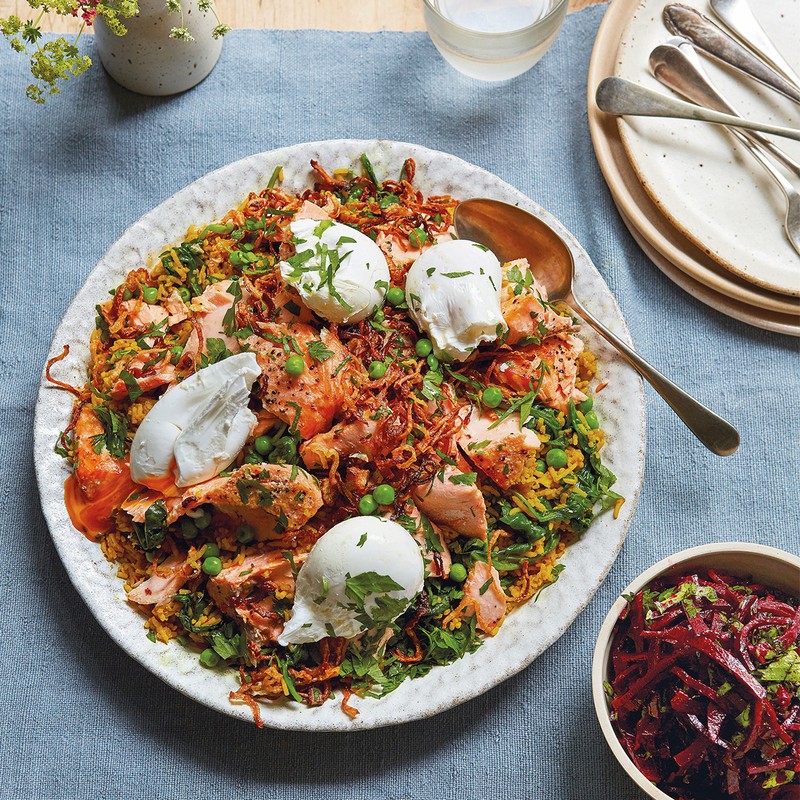How To Make A Decent Brunch At Home
When we opened Sunday in Islington, were part of the early wave of ‘proper’ brunch destinations in London, who took it seriously as a legitimate meal, as opposed to something that was an accidental overhang from breakfast. We knew brunch was being done elsewhere, but not as well as we would like, so we made it part of our mission to change that. We always wanted Sunday to be the kind of establishment where we would want to take our own family and friends, and that remains our guiding principle.
We focus on doing the classics well, with a modern twist and a respect for seasonal produce. Our menu is constantly changing to reflect seasonal ingredients and whatever inspires us. The result is a range of creative, flavoursome, and varied dishes, incorporating international influences, and providing plenty of choice for sweet and savoury brunchers alike.
Brunch celebrates what is arguably the most joyous meal of the day. We felt brunch came out of nowhere, and as such, it’s been able to make up its own rules; it can be enjoyed any time of day; it can be entirely sweet or savoury, or both in equal measure (a savoury dish followed by a half/full stack of pancakes is a popular choice at Sunday); it can be easy or complex; it can be a social ‘event’, bringing people together or a casual, laid-back affair. More than anything, to us brunch is fun, which is what good food should be.
Inspired? Here are four simple yet substantial brunch dishes to make at home…
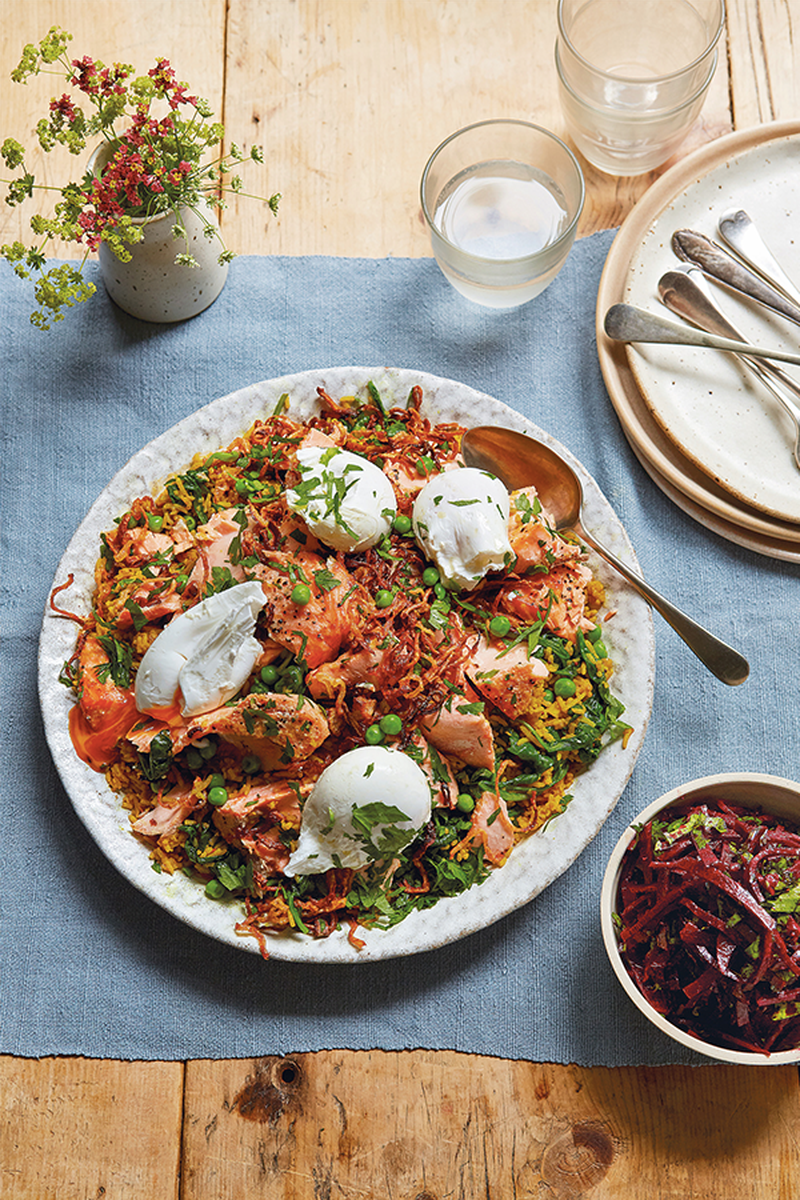
Salmon Kedgeree With Beetroot Slaw
This dish is designed to be shared. Served on a large platter, the different layers and textures will be a feast for the eyes and the palate. The fresh and vibrant beetroot slaw is a perfect accompaniment to the fragrant, spicy rice and the hearty salmon.
INGREDIENTS
- 2 x 200g salmon fillets, skins removed
- 2 tbsp of olive oil, plus extra for brushing
- Zest of 1 lemon, finely grated
- 300g of basmati rice
- 1 small onion, finely chopped
- 4 garlic cloves, finely chopped
- 2 tbsp of ground coriander
- 2 tbsp of ground cumin
- 1½ tbsp of ground turmeric
- 6 cloves
- 6 black peppercorns
- 1 cinnamon stick
- 6 curry leaves
- 6 green cardamom pods, slightly crushed
- 1 tbsp of sea salt
- 100g of peas, steamed or boiled
- Sea salt and black pepper
For the beetroot slaw:
- 2 medium raw beetroot, grated
- 1 garlic clove
- 4 tbsp of white wine vinegar
- 2 tbsp of olive oil
- 1 tbsp of lemon juice
- 1 handful of fresh coriander, finely chopped
- 1 handful of fresh mint, finely chopped
For the crispy onions:
- 1 large onion, finely sliced
- 500ml of vegetable oil
To serve:
- 4 poached eggs
- 1 handful of fresh parsley, chopped
METHOD
- Combine all the ingredients for the beetroot slaw in a bowl and mix well. Cover and leave to rest in the fridge until needed.
- Preheat the oven to 180°C fan/200°C/gas 6. Place the salmon fillets on a baking tray lined with parchment. Brush with olive oil, sprinkle with the lemon zest and season with salt and pepper. Bake for 15 minutes, or until just cooked, then allow to cool. Once cool, break into large flakes with a fork, and set aside.
- Place the basmati rice in a large bowl and rinse under water until the water runs clear. Cover the rice with fresh water and leave to soak for 30 minutes. This will help to reduce the cooking time.
- Heat the 2 tbsp of oil in a large heavy-bottomed pan over a medium heat. Add the onion and sauté for about 5 minutes until it is translucent. Add the garlic and cook for 2 minutes.
- Add the coriander, cumin, turmeric, cloves, peppercorns, cinnamon, curry leaves and cardamom, and fry or a couple of minutes. Add some more oil if it becomes too dry – you want a paste-like consistency.
- Drain the rice and add to the pan, mixing well to ensure that it is well coated with the spice paste. Add 600ml of water and salt. Increase the heat to high to bring it to the boil. Reduce the heat to low, cover, and simmer for around 30 minutes or until the rice is cooked.
- While the rice is cooking, prepare the crispy onions. Heat the vegetable oil in a wok over a medium heat. Test the oil’s heat by dropping in a slice of onion to test; if it dances and fizzes on the surface of the oil, the temperature is correct. Add the onions and fry until golden, stirring to make sure the onions nearest the wok edges don’t burn.
- Using a slotted metal spoon, remove the onions from the oil when they are a shade or two lighter than your desired shade, as they will continue to cook after being removed from the oil. Place on kitchen paper to soak up any excess oil.
- Just before the rice is cooked, remove the cinnamon stick, cloves and cardamom pods from the pan. Add the peas and cook for a couple of minutes as the rice finishes cooking.
- To serve, spoon the rice onto a large platter. Top with the flaked salmon, poached eggs, crispy onions, and a generous amount of chopped parsley. Serve with the beetroot slaw on the side.
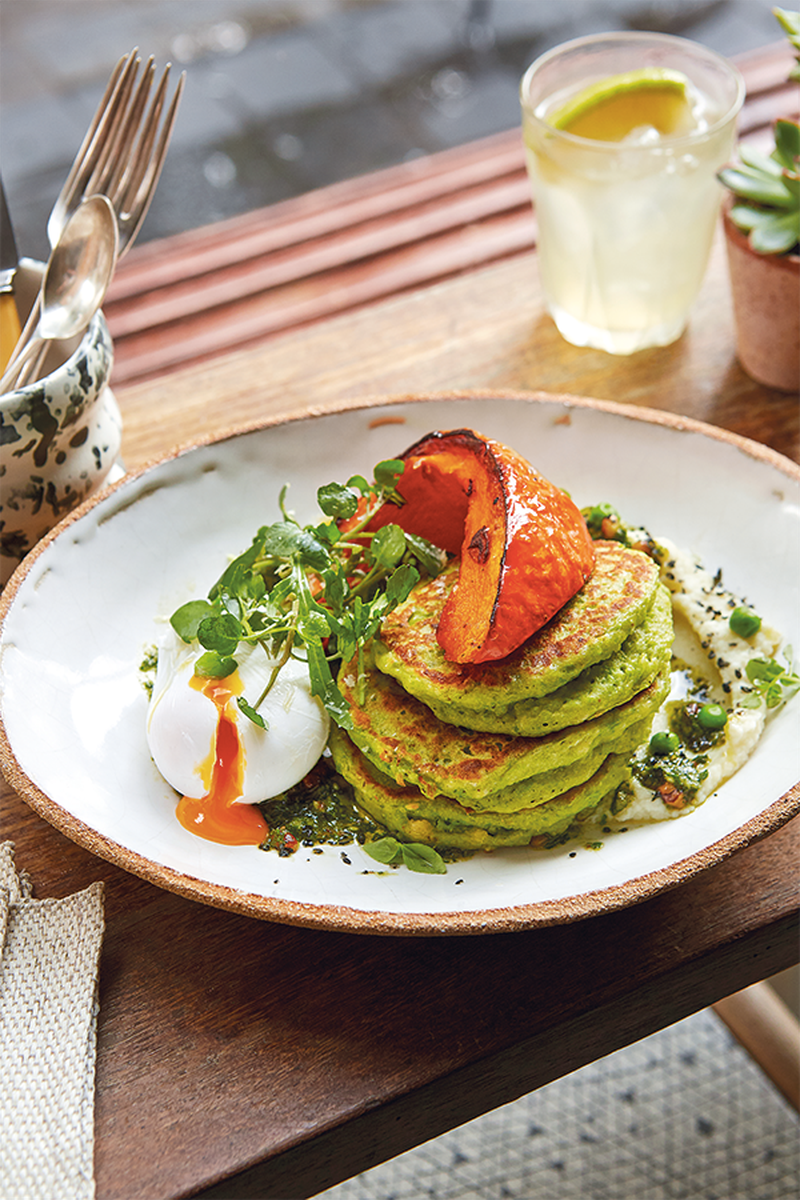
Spinach, Pea & Parmesan Pancakes
Onion squash is one of the earliest squashes of the season. Its soft skin needs no peeling, and it has a delicious sweetness which is enhanced through roasting, but butternut squash makes a good substitute if you can’t find it. Both look great against the vibrant green pancakes.
INGREDIENTS
- 25g of butter, plus extra for cooking the pancakes
- 60g of spinach, washed and dried
- 100ml of milk
- 100g of boiled or steamed peas
- 6 large mint leaves
- 200g of self-raising flour
- 1 tsp of baking powder
- 3 eggs
- 100g of parmesan cheese, grated
For the roasted squash:
- 1 small onion squash
- 2 tbsp of olive oil
- Zest of 1 lemon
For the cauliflower puree:
- ½ small cauliflower
- 1 garlic clove
- 1 tbsp of cream cheese
- Pinch of nutmeg, freshly grated
For the pesto:
- 1 good handful of basil
- 1 good handful of parsley
- 2 garlic cloves
- 50g of pine nuts
- 120ml of olive oil, plus extra for storing
- 50g of parmesan cheese, grated
- Sea salt and black pepper
To serve:
- 2 poached eggs
- Handful of rocket
- Parmesan shavings
METHOD
- First, make the pesto. Put the basil, parsley, garlic and half the pine nuts into the bowl of a food processor and blitz until it’s combined and smooth (you can also use a stick blender). While the processor is still running, pour in the olive oil in a steady stream. Stop the machine and scrape down the sides. Transfer the pesto to a bowl and fold in the remaining pine nuts and the parmesan. Add salt and pepper to taste. Store the pesto in a jar in the fridge, topped with a layer of olive oil to seal, for up to 5 days.
- Next, prepare the onion squash. Preheat the oven to 170°C fan/190°C/gas 5. Slice the squash in half and scoop out the seeds, then cut it into 2.5cm (1in) thick slices. Place the slices in a bowl and drizzle with the olive oil. Add the lemon zest and seasoning and mix it all together, massaging into the squash.
- Transfer the slices to a roasting dish and roast in the preheated oven for 25 minutes until soft and caramelising at the edges.
- While the squash is cooking, prepare the cauliflower purée. Cut the cauliflower in half so you have two pieces. Cut out the core and discard, then break the rest into large florets. Bring a pan of salted water to the boil and add the florets and garlic. Cook for around 15 minutes until tender.
- Drain off the water and transfer the cauliflower and garlic to a food processor. Add the cream cheese, a pinch of grated nutmeg and salt and pepper to taste and blitz until smooth and creamy. Transfer to a small pan so you can warm it gently before serving.
- Now prepare the pancakes. Start by melting the butter in a frying pan over a medium heat. Add the spinach and cook until just wilted. Transfer the cooked spinach to a mixing bowl and add the milk, half the peas and the mint leaves. Purée everything together using a stick blender until smooth. Add the rest of the peas and roughly blitz for another few seconds so that the peas are roughly chopped but there is still some texture in the batter.
- Add the flour, baking powder, eggs and parmesan to the mixture and mix with a wooden spoon until evenly combined. Don’t worry if there are still a few lumps in the batter. What will emerge is a rather thick, beautiful, vibrantly green batter. Let it rest for 10 minutes.
- Melt a knob of butter in a large non-stick frying pan over a medium heat. Spoon 3 tbsp of batter per pancake into the pan. Depending on the size of your pan you should be able to cook 2-3 pancakes in one go. Cook the pancakes for 3-4 minutes on each side until they are golden green-brown. Repeat until you have 6 pancakes, adding a little more butter to the pan when needed.
- Warm the cauliflower purée gently in the pan and spread 3 tbsp on each plate. Layer with a stack of three pancakes, a couple of slices of roast squash and a poached egg. Garnish with a few rocket leaves and some parmesan shavings.
- Finish off with a good drizzle of the pesto and serve.
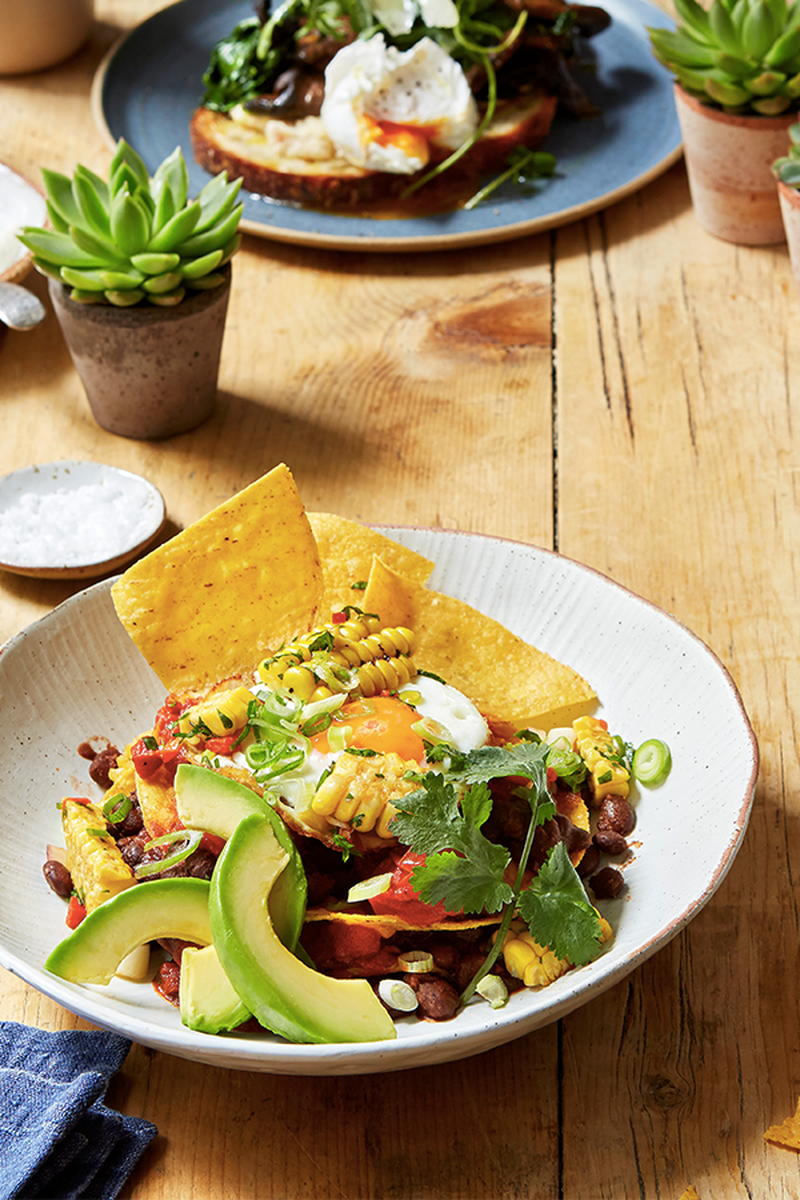
Huevos Rancheros With Spicy Black Beans & Roast Corn Salsa
INGREDIENTS
- 1 tbsp of olive oil
- ½ small Spanish onion, finely diced
- 2 garlic cloves, finely chopped
- 1 sprig of thyme
- 3 cherry tomatoes, halved
- 200g of good-quality tinned chopped tomatoes
- 4 tbsp of rapeseed oil
- 6 fresh Mexican corn tortillas
- 2 eggs
- 4 sprigs of fresh coriander
- 1 avocado, sliced
- Sea salt and black pepper
For the spicy black beans:
- 250g of dried black beans, soaked in a bowl of cold water in the fridge overnight or 2 400g tins of black beans, drained and rinsed
- 3 tbsp of olive oil
- 1 small Spanish onion, finely diced
- 3 garlic cloves, finely chopped
- 2 tsp of ground cumin
- ½ small chipotle chilli, finely chopped
- 1 tin of good-quality chopped tomatoes
- 1 tsp of sea salt
- ½ tsp of black pepper
- 1 small bunch coriander, roughly chopped
For the roast corn salsa:
- 2 corn on the cob, husks removed
- 3 tbsp of olive oil
- ½ red onion, finely diced
- 1 red pepper, finely diced
- 2 spring onions, finely sliced
- ½ red chilli, deseeded and finely diced
- 30g of coriander, chopped
- Sea salt and black pepper
METHOD
- Make the black beans the night before. First drain the soaked black beans then rinse them under cold water for 1 minute. Put them in a pan and add 1 litre of water. Set the pan over a medium heat and cook for 45 minutes.
- While the beans are cooking, heat a small non-stick frying pan over a medium heat, add the oil, onion and garlic, and sauté for 2-3 minutes until softened. Add the cumin and chilli and sauté for a further 2 minutes.
- After 45 minutes, add the onion mix to the beans, along with the tomatoes. Season with the salt and pepper and reduce to a low heat so that the beans are simmering.
- Cook for a further 1 hour 15 minutes, stirring occasionally, until the beans are soft. Store in the fridge overnight.
- On the day of serving, first make the corn salsa. Preheat the oven to 170°C fan/190°C/gas 5. Bring a large pan of water to the boil. Add the corn and cook for 4 minutes, then drain the cobs in a colander.
- Place the corn on a roasting tray, drizzle with 1 tbsp of the olive oil and season. Roast for 8 minutes until starting to turn golden, then remove from the oven and allow to cool.
- Once cool, remove the corn from the cob using a small serrated knife. Put it in a mixing bowl and add the red onion, pepper, spring onions, chilli, coriander and the remaining olive oil. Season to taste and mix well.
- Preheat the oven to 160°C fan/180°C/gas 4.
- Heat the black beans in a small pan over a low heat. Heat a small pan over a medium heat and add the olive oil and onion. Cook for 1 minute, then add the garlic and thyme. Cook for a further 2-3 minutes until the onion is lightly coloured and softened.
- Add the cherry and chopped tomatoes, season with salt and pepper, stir well and lower the heat to medium-low. Cook for 15-20 minutes, stirring occasionally, until you have a rich tomato sauce. Remove the thyme and discard.
- Put 2 tbsp of the rapeseed oil into a small bowl and, using a pastry brush, lightly brush both sides of the corn tortillas. Cut 2 of the tortillas into wedges then place all of the them on a large non-stick baking tray (use two trays if you need to) and bake for 8-12 minutes until slightly golden and crisp.
- Remove the whole tortillas from the tray onto a cooling rack. The centre of the tortillas may still be a bit soft, but they will crisp up once they cool down. Leave the tortilla wedges to cool on the baking tray.
- For the eggs, heat a frying pan over a medium heat and add the remaining 2 tbsp of rapeseed oil. Once hot enough to fry, crack 2 eggs into the pan and fry to your liking.
- Serve 2 whole tortillas per person and top with the black beans and tomato sauce. Place a fried egg on top of each plate and add 2 tbsp of corn salsa and a couple of sprigs of coriander.
- Serve with sliced avocado and a bowl of the tortilla chips to dip in your fried egg
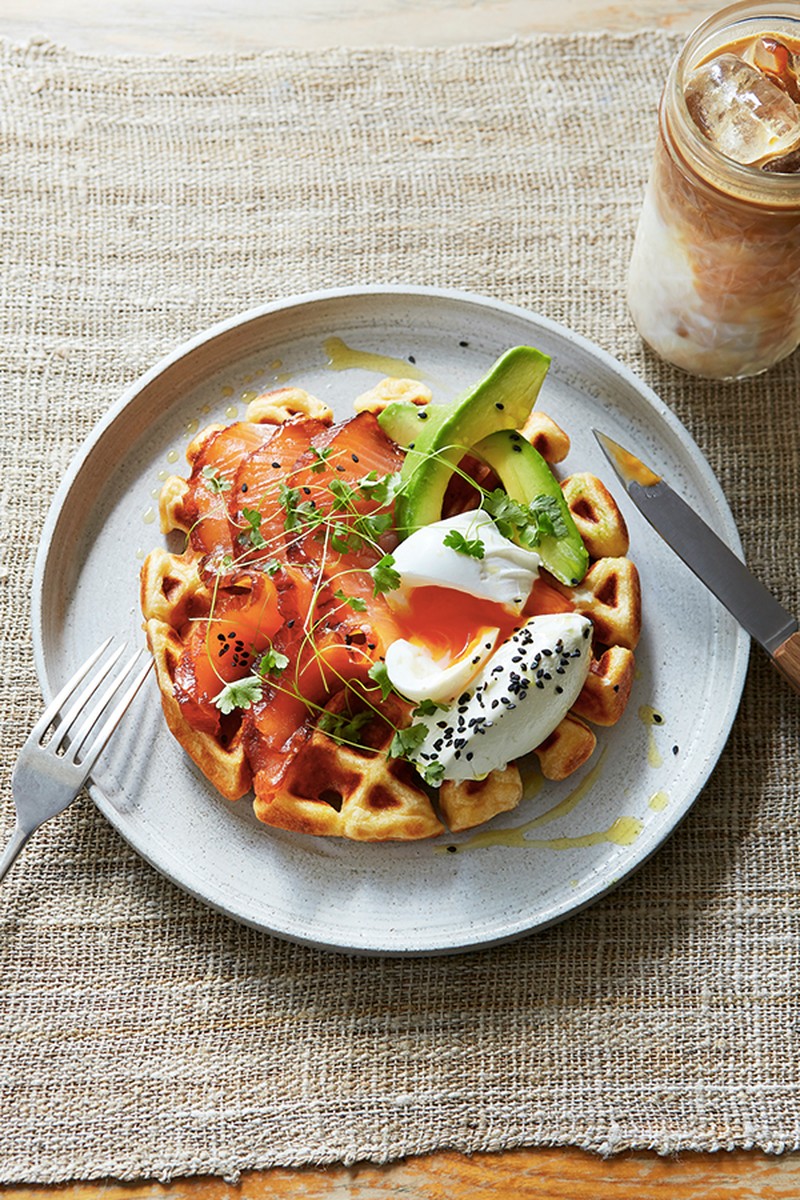
Buttermilk Waffles With Cured Salmon & Wasabi Cream Cheese
For the salmon, ask your fishmonger for a thick piece from the middle of the fish – this will help even curing all over. Remove the brown, oily meat as well. You can cure the salmon in a zipper bag or plastic container – just don’t use anything metal.
INGREDIENTS
- 2 poached eggs
- ½ avocado, peeled, stoned and sliced
- 1 spring onion, finely sliced
- 1 tsp of black sesame seeds
- A few sprigs fresh coriander
- Olive oil, to drizzle
For the cured salmon:
- 250ml of light soy sauce
- 250ml of maple syrup
- 50g of sea salt
- Half a bunch of fresh coriander, chopped (leaves and stalks)
- 5cm piece of fresh ginger, peeled and grated
- 2 garlic cloves, finely sliced
- 1 green chilli, chopped
- Juice and zest of 1 lime
- 500g of salmon fillet, bones and brown meat removed
For the wasabi cream cheese:
- 2 heaped tbsp of full-fat cream cheese
- 1 tsp of wasabi paste
- Juice of 1 lime
For the waffles:
- 150g of plain flour
- 1 tsp of baking powder
- Pinch of sea salt
- 50g of butter, melted
- 250ml of buttermilk
- 2 eggs, beaten
- Oil spray, for greasing
METHOD
- For the salmon, whisk together the soy sauce, maple syrup and salt in a bowl until the salt has dissolved. Add the coriander, ginger, garlic, chilli and lime juice and zest, and mix well. Place the salmon in a large zipper food storage bag or plastic container and pour over the curing marinade. Make sure the salmon is submerged in the marinade. Cover (or zip the bag shut) and place in the fridge for 24 hours.
- Remove the salmon from the fridge and rinse under cold water to remove the marinade. The salmon will have taken on a tinge of colour from the fragrant soy-based cure. Pat the fillet dry. Using a sharp knife, slice the salmon at a 45-degree angle into 5mm slices. Lay the slices flat on a plate and tightly cover with cling film so that it is airtight. Refrigerate until needed.
- Combine all the ingredients for the wasabi cream cheese in a small bowl. Cover and refrigerate until needed.
- Prepare the waffle mix by combining the flour, baking powder and salt in a bowl. Mix the wet ingredients in a separate bowl, then add the wet to the dry and whisk together gently until the batter is smooth, taking care not to overbeat.
- Heat up the waffle machine and spray with oil. Pour a ladleful of waffle batter into the machine and cook for 3-4 minutes or until golden brown and crispy on the outside. Repeat so you have two waffles. While the waffles are cooking, poach the eggs.
- Assemble each serving plate by placing a few slices of cured salmon across one half of each waffle. Add a neatly heaped tablespoon of wasabi cream cheese then place the poached egg on an empty quarter of the waffle with the sliced avocado on the remaining quarter. Garnish with the spring onion, black sesame seeds and a few sprigs of coriander, and finish off with a drizzle of olive oil. Serve and enjoy.
Brunch The Sunday Way is published by Frances Lincoln and is available to buy here
Follow @SundayBarnsbury
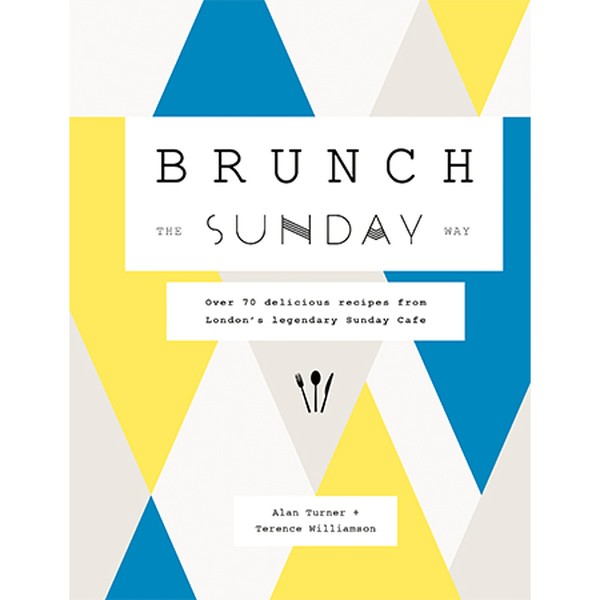
DISCLAIMER: We endeavour to always credit the correct original source of every image we use. If you think a credit may be incorrect, please contact us at info@sheerluxe.com.
